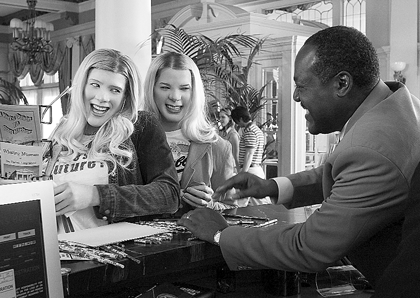Wayans Brothers’ gender satire less biting than Wilder’s
“White Chicks,” the latest movie starring Shawn and Marlon Wayans, and directed by their brother Keenan Ivory, is particularly prone for a feminist analysis.
Satire is the favorite way for these brothers to communicate (think “I’m Gonna Git You Sucka” and “Scary Movie”) and they tend to base their jokes on contemporary attitudes about class, race, sexuality, and gender.
“White Chicks” experiments with all of these, since Shawn and Marlon’s characters Kevin and Marcus start off as middle-income, black, straight men and temporarily transform themselves into wealthy, white, sexually ambivalent women. Although the film is chock-full of class and race parodies, gender and sexuality issues take center stage, and the film joins a large collection of mainstream gender-disguise movies that examine, but then reinforce heterosexual identities.
The plot may seem familiar: two good buddies get into a bind and have to dress up as women to resolve it. The buddies pull out all the stops by using wigs, makeup, accessories, gestures, and in this case, paint and prosthetics, to pull off their absurd plan. We, the audience, can easily identify the disguises, but the characters within the film are fooled. The buddies struggle with their new gender costumes—long hair, bras, and panty hose are so darned uncomfortable!—and repeatedly reveal themselves to be manly men underneath all that gear.
High jinks ensue, and one of the buddies falls in love with a fair maiden, though he can’t woo her because he is a “woman.” The other buddy has to thwart the advances of a male character who is hopelessly attracted to “her” unusual beauty. Finally, after a series of misadventures, the buddies are unmasked, the day is saved, and there are a lot of heterosexual hook-ups.
“White Chicks,” Billy Wilder’s 1959 classic “Some Like it Hot,” and a slew of other films share this generic formula, which has been identified by queer theorist Chris Straayer in her book, “Deviant Eyes, Deviant Bodies.” Straayer calls the genre “the temporary transvestite film,” and investigates its mass audience appeal, a phenomenon that can hardly be denied, since “Some Like it Hot” debuted 45 years ago and “White Chicks” was released last week.
Straayer argues that the very existence of the genre indicates a common desire to experience a world with fewer gender and sexuality constraints.
“The fact that the plot is generic strongly suggests that this process is never finished and that the generic system fulfills the viewer’s desire to return again and again to a less closed situation,” Straayer wrote.
In other words, mainstream audiences attend films like “White Chicks” because they enjoy a brief encounter with gender fluidity now and then.
It is enjoyable to observe the Wayans duo perform as men and women at once, and it’s fun to see gender presented as a costume that can be put on and taken off. And there is some satisfaction in watching traditional heterosexual men deal with the perils of catcalls as well as thongs. The brothers also learn about shopping, inattentive boyfriends, and body image issues. Straayer explained all this as “cross-gender sensitization,” a typical feature of these movies that allows the heroes to empathize with what the film itself defines as the plight of the opposite sex.
But the film doesn’t completely fulfill Straayer’s 1996 theory. Typically, temporary transvestite films, such as “Some Like it Hot,” include a paradoxical kiss involving a disguised character. But “White Chicks” doesn’t permit any such homosexual references. In “Some Like it Hot,” Josephine (Tony Curtis) kisses Sugar (Marilyn Monroe), which allows for a homosexual reading on the visual level. The Wayans brothers, however, refuse to put themselves in that situation (Shawn and Marlon wrote and produced the film along with older brother Keenan Ivory).
In fact, the Wayans won’t let their audiences experience as much sexuality-and-gender-bending as “Some Like it Hot” audiences did two generations ago. Somehow, in 1959, Jack Lemmon was allowed to go off into the sunset with Joe E. Brown, but in 2004, Shawn Wayans will have none of the oh-so-buff Terry Crews.
The homophobic jokes sprinkled throughout the film would not surprise famous feminist theorist Judith Butler, who discusses these types of films in “Bodies That Matter.” Butler and Straayer agree that these films experiment with gender and sexuality norms before reinforcing them. But, from Butler’s perspective, these films are hermetically sealed bubbles in which queerness is created, examined, experienced in a way that does not threaten heterosexual privilege, and then destroyed. In short, the temporary transvestite film is a way for heterosexual culture to fortify its boundaries and keep queerness out. Indeed, the Wayans brothers seem to police the boundaries of heterosexuality through their characters, who are, appropriately, FBI agents.
While the queer community is likely to roll its collective eyes at “White Chicks” and then ignore it, the film is one of the many hidden places where dominant gender and sexuality norms, as well as blatant homophobia, are re-fed to the public. And the film is a reasonably powerful force—it earned $14.2 million in its first week in theaters, battling “Fahrenheit 9/11” for a top spot at the box office.



































